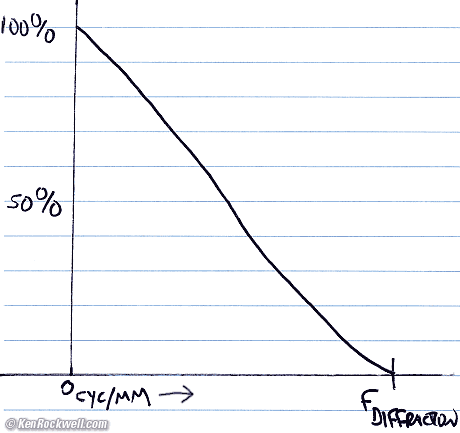Home Donate New Search Gallery Reviews How-To Books Links Workshops About Contact
Diffraction
© 2012 KenRockwell.com. All rights reserved.
This free website's biggest source of support is when you use these links when you get anything, regardless of the country in which you live. Thanks! Ken.
INTRODUCTION
|
Adorama pays top dollar for your used gear. I use Adorama, Amazon, eBay, Ritz, B&H, Calumet, J&R and ScanCafe. I can't vouch for ads below.
|
Diffraction is a loss of sharpness or resolution caused by photographing with small f/stops. The same softening effect happens when photographing through diffusion cloth or window screens.
Anytime you look or photograph through small holes you get diffraction. Squint your eyes - that's diffraction! Look or photograph through a screen window or through a small f/stop and you get the equivalent of a soft-focus filter.
See Sharpness vs. Aperture for better example photos. See my Zenitar 16mm Fisheye review, where I explicitly show a crappy lens completely obliterating the performance of a Nikon 10.5mm DX fisheye due to diffraction and its different effects at each aperture.
See also this site with many more illustrations.
MATH (feel free to skip to examples)
See MTF Curves for an even better technical explanation.
Laypeople think diffraction is caused by light rays bending around sharp edges. Physicists know the limiting resolution is defined by the diameter of the Airy disc which is defined by the f/number, and astronomers and spy satellite designers know that angular resolution is defined by the diameter of the clear aperture.
Diffraction is accurately predicted by both ray and wave theory.
Theoretical maximum resolution is limited by f/number. A perfect lens can do this under perfect conditions. A lens this good is called "diffraction limited." Few lenses reach this level at large apertures. Most lenses meet these levels at small apertures, because the resolution limits are so low at f/22.
f/ |
line pairs per mm |
1.4 |
1,100 |
2 |
800 |
2.8 |
565 |
4 |
400 |
5.6 |
283 |
8 |
200 |
11 |
141 |
16 |
100 |
22 |
71 |
32 |
50 |
45 |
35 |
64 |
25 |
90 |
17 |
128 |
12 |
These limiting resolutions are the resolutions at which contrast falls to zero. The contrast is reduced as the resolution approaches these figures. If you have a system which only resolves 50 l/mm, you can still see a loss of sharpness if you stop a lens down to f/16 which can resolve 100 l/mm. This is because the contrast falls at the lower resolutions which the system can see. You have 0% contrast at the limiting resolution, and about 50% contrast at half that resolution. The percent contrast vs. resolution curve is called Modulation Transfer Function (MTF). MTF is similar to a frequency response curve.
The Nikon D200 resolves about 100 lines per mm. (The D200 has about 3,800 pixels across 24mm, or 160 pixels per mm. Due to Bayer Interpolation, the anti-alias filter in all cameras and the fact that a line pair requires both a light and a dark pixel, the D200 resolves about 2,500 lines horizontally. 2,500 lines / 24 mm = 100 l/mm.) Thus I can see a loss of sharpness in the examples below starting at f/8, with a theoretical resolution of 200 l/mm.
Large format photographers can get away with small apertures like f/64 because our film is so big. We have so many more millimeters horizontally and vertically that we still have enough resolution. Of course even with large formats it's best to shoot at as large an aperture as possible. That's why I researched and wrote my Selecting the Sharpest Aperture piece years ago.

Diffraction-Limited MTF. F(diffraction) = 1,800 / f/stop.
Diffraction is worst at small f/numbers, like f/22, and not an issue at large f/numbers like f/4.
The resolution at which the graph falls to zero is calculated as 1,800 / f/stop. For instance, at f/18, it's at 100 cyc/mm, and for f/1.8, it's 1,000 cyc/mm.
Of course at large f/numbers like f/1.8 we're limited by our lens' quality, but stopped down, we're limited by diffraction.
If our resolution falls to zero at a certain resolution, we get nothing but gray, but more importantly, we get much less modulation percentage (sharpness) at lower resolutions.
For instance, at f/18 where our modulation falls to zero at 100 lines per mm, it is only 40% at 50 lpmm. Diffraction isn't a straight line to zero, it's a bit less than 50% at 50% resolution. (see MTF Curves for explanations.)
Nikon's lowest resolution camera, my favorite Nikon D40, has 3,008 pixels horizontally along its 23.7mm DX sensor, or 127 pixels per mm. It takes two pixels to make a cycle, so the D40 has a pitch of 63 cyc/mm.
At f/18, even a perfect lens has only about 50% modulation at the finest details seen by even a D40. (Higher resolutions may appear, but only as aliases. Again, see MTF Curves for explanations.)
This is why images made at small apertures can look so soft, and why point-and-shoots, which have even smaller sensors, won't stop down any smaller than f/8. In fact, the compacts I own which do indicate smaller than f/8 do it with neutral density filters.
This is why I own a 0.9 3-stop ND filter. I use it for longer exposures of moving water, since I avoid shooting digital SLRs smaller than f/11.
EXAMPLES
These are 100% magnification crops from the centers of much larger images. These images would be about 2 x 3 feet if printed at this magnification.
I shot these with my 55mm f/2.8 Micro on my D200. Engineers at a Kodak laboratory here in San Diego tested other samples of this lens on their MTF machine and reported its central resolution to be diffraction limited by f/5.6. This means that this lens is as good as it gets, and perfect for these examples.
 |
 |
 |
 |
 |
 |
ANALYSIS and RECOMENDATIONS
I see sharpness declining at f/8 or f/11. It looks awful at f/32. I see this on my other lenses, too.
Unless you absolutely need depth of field, avoid apertures smaller than f/8 on modern digital SLRs. Their resolving power is so great that you will soften your images by stopping down unnecessarily. This is why many point-and-shoot cameras don't stop down past f/8.
See also my very advanced page on Selecting the Sharpest Aperture.
More information about diffraction: Cambridge in Color.
Help me help you top
I support my growing family through this website, as crazy as it might seem.
The biggest help is when you use any of these links to Adorama, Amazon, eBay, Ritz, Calumet, J&R and ScanCafe when you get anything, regardless of the country in which you live. It costs you nothing, and is this site's, and thus my family's, biggest source of support. These places have the best prices and service, which is why I've used them since before this website existed. I recommend them all personally.
If you find this page as helpful as a book you might have had to buy or a workshop you may have had to take, feel free to help me continue helping everyone.
If you've gotten your gear through one of my links or helped otherwise, you're family. It's great people like you who allow me to keep adding to this site full-time. Thanks!
If you haven't helped yet, please do, and consider helping me with a gift of $5.00.
As this page is copyrighted and formally registered, it is unlawful to make copies, especially in the form of printouts for personal use. If you wish to make a printout for personal use, you are granted one-time permission only if you PayPal me $5.00 per printout or part thereof. Thank you!
Thanks for reading!
Mr. & Mrs. Ken Rockwell, Ryan and Katie.
Home Donate New Search Gallery Reviews How-To Books Links Workshops About Contact



